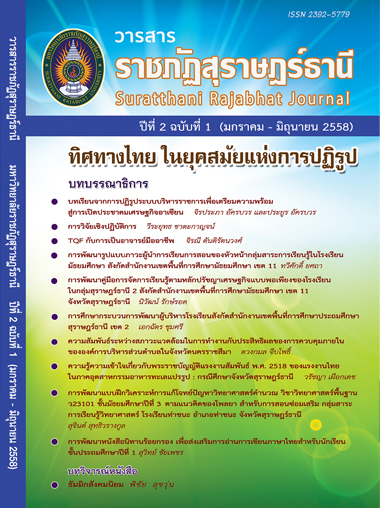Development of Instructional Leadership Model of Department Heads in Secondary Schools under the Secondary Educational Service Area Office 11
Main Article Content
Abstract
The objectives of the research were to develop and examine the instructional leadership model of department heads in secondary schools under the Secondary Educational Service Area Office 11. This research consisted of 3 stages. Stage one was the study of related literature and research, case studies of the school administrators and department heads which were 2 best practices and successful schools. Stage two was the development of instructional leadership model of department heads by 12 experts on focus group discussion. Stage three was the investigation of instructional leadership model of department heads by 16 experts on public hearing. The instrument for collecting data was 123 questions with 0.88 reliabilities.
Research findings were as follows : the instructional leadership model for department heads in secondary schools under the Secondary Educational Service Area Office 11 included 6 major dimensions: determination of direction for change, curriculum development and instructional, technology use new learning environment creation, development of professional teachers and student development to excellence, supervision and assessment of teaching. The results of the investigation by experts comments showed that: instructional leadership model of department heads in secondary schools under the Secondary Educational Service Area Office 11 was accurate, appropriate, possible, and beneficial in every aspect.
Article Details
References
ชัยรัตน์ หลายวัชระกุล. (2547). การพัฒนาหลักสูตรฝึกอบรมเสริมสร้างภาวะผู้นำทาง การเรียนการสอนสำหรับผู้บริหารโรงเรียนมัธยมศึกษา. วิทยานิพนธ์การศึกษาดุษฎีบัณฑิต สาขาวิชาการบริหารการศึกษา บัณฑิตวิทยาลัย มหาวิทยาลัยขอนแก่น.
ธีระพร อายุวัฒน์. (2552). แนวปฏิบัติที่เป็นเลิศในการบริหารงานวิชาการของสถานศึกษาขั้นพื้นฐาน. ดุษฎีนิพนธ์ปรัชญาดุษฏีบัณฑิต สาขาวิชาการบริหารการศึกษาบัณฑิตวิทยาลัย มหาวิทยาลัยศิลปากร.
มะลิวรรณ ประวัง และคณะ (2551). การพัฒนาภาวะผู้นำของหัวหน้ากลุ่มสาระการเรียนรู้ตามหลักสูตรการศึกษาขั้นพื้นฐาน พ.ศ. 2544. วิทยานิพนธ์การศึกษามหาบัณฑิต สาขาวิชาการบริหารการศึกษา มหาวิทยาลัยนเรศวร
วัชรี เลียนบรรจง. (2555). บทบาทในการสนับสนุนการนิเทศการจัดการเรียนของผู้บริหารสถานศึกษา [ออนไลน์]. เข้าถึงได้จาก http://www.gotoknow.org/blogs/ posts/359043 [2556, กันยายน 25]
วัฒนาพร ระงับทุกข์. (2545). เทคนิคและกิจกรรมการเรียนรู้ที่เน้นผู้เรียนเป็นสำคัญ ตามหลักสูตรการศึกษาขั้นพื้นฐาน พ.ศ. 2544. กรุงเทพฯ : พริกหวานกราฟฟิค.
สำนักงานเขตพื้นที่การศึกษามัธยมศึกษา เขต 11. (2555). แนวทางการเพิ่มผลสัมฤทธิ์ทางการเรียนระดับชาติ (O-NET) เพื่อยกระดับคุณภาพผู้เรียนของสำนักงานเขตพื้นที่การศึกษามัธยมศึกษา เขต 11. สุราษฎร์ธานี : ผู้แต่ง.
. (2556). รายงานผลการทดสอบทางการศึกษาขั้นพื้นฐานระดับชาติ (O-NET) ปีการศึกษา 2555 ชั้นมัธยมศึกษาปีที่ 3 และชั้นมัธยมศึกษาปีที่ 6 โรงเรียนในสังกัดสำนักงานเขตพื้นที่การศึกษามัธยมศึกษา เขต 11. สุราษฎร์ธานี : ผู้แต่ง.
สำนักงานคณะกรรมการการศึกษาขั้นพื้นฐาน. (2550). คู่มือปฏิบัติงานด้านบริหารทั่วไปสำนักงานเขตพื้นที่การศึกษาตามกฎกระทรวงกำหนดหลักเกณฑ์และวิธีการกระจายอำนาจการบริหารและการจัดการศึกษา พ.ศ.2550. กรุงเทพฯ : กระทรวงศึกษาธิการ.
สำนักงานรับรองมาตรฐานและประเมินคุณภาพการศึกษา (องค์การมหาชน). (2555). การสังเคราะห์ข้อมูลผลการประเมินรอบสาม (2554 - 2558) ระดับการศึกษาขั้นพื้นฐาน [ออนไลน์]. เข้าถึงได้จาก http://www.onesqa.or.th/upload/ 195/FileUpload/1398_2097.pdf [2555 ตุลาคม 22]
สำนักงานเลขาธิการสภาการศึกษา. (2552). ข้อเสนอการปฏิรูปการศึกษาในทศวรรษที่สอง (พ.ศ. 2552 - 2561). กรุงเทพฯ : กระทรวงศึกษาธิการ.
เสาวนี ตรีพุทธรัตน์ และคณะ. (2555). เอกสารประกอบการสอนวิชาการบริหารจัดการสถานศึกษา. ขอนแก่น : คณะศึกษาศาสตร์ มหาวิทยาลัยขอนแก่น.
Cunningham, W. G. & Cordeiro, P. A. (2003). Educational Leadership: A Problem -Based Approach. Boston : Allyn and Bacon.
Dimmock and Walker. (2005). The Leadership Behavior of Principals and Their Effect on School Improvement in Effective Urban High School. Dissertation International.
David, C. and Magaret. (1989). Leadership in Organization (2nd ed.). Englewood Cliffs : New jersey : Prentice - Hall.
David, G. A. & Thomus, M. A. (1989). Effective School and Effective Teachers. Boston : Allyn and bacon
Eisner, E.W. (1976). The Art of Human Development and Education. Berkley Calif : Mc Cupchan Pub.
Hallinger, P. and Murphy, J. (1985).Assessing the Instructional Management Behaviors of Principals. Taylor and Francis ; Ltd.
Harriss, B. M. (1985). Supervisor Behavior in Education (3rd ed.). Englewood Cliffs : New jersey : Prentice - Hall.
Krug, S. (1992). Instructional Leadership : A constructivist perspective. New Jersey : Prentice- Hill.
Marks, J. R., Emergy, Stoops.& King, S. (1978). Handbook of Educational Supervisor :A Guide for The Partitions. Boston : Allyn and Bacon.
McEwan, E. K. (1998). Seven Steps to Effective Instructional Leadership. California : Library of congress.
Murphy, J. (1990). Principal instructional leadership.Advances in Educational Administration. Forum Qualitative Social Research, 1(2, June). Available : http://www.qualitative-research.net /fqs/fqs-e/2-00inhalt-e.htm [2012 March 14]
Supovitz and Poglinco. (2001). The principal ship : A reflective practice perspective. Boston : Allyn and Bacon.
Wildy, H. & Dimmock, C. (1993). Instructional leadership in primary and secondary schools in Western Australia. Journal of Educational Administration. Retrieved December 1, from ABI/INFORM Global.
Yamada, A.T. (2001). Elementary School Principal’s Perceptions of Responsibilities and Competencies for Instructional Leadership. University of the Pacific Stockton : California.


